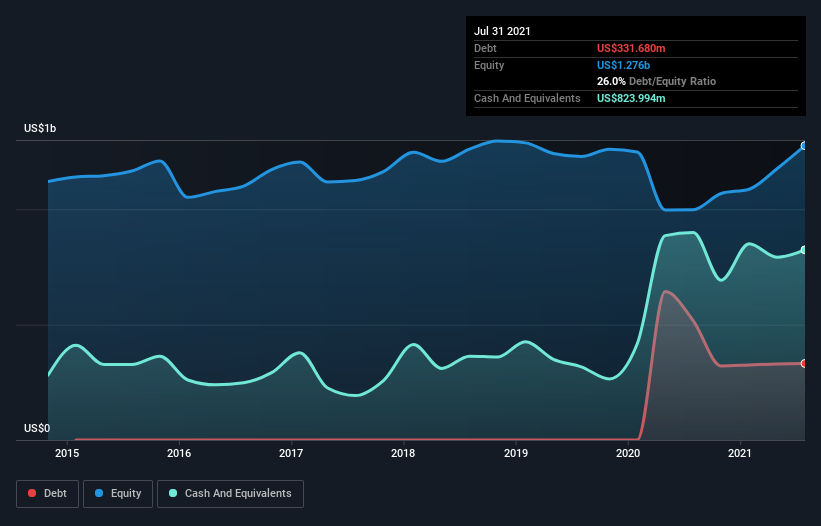These 4 Measures Indicate That American Eagle Outfitters (NYSE:AEO) Is Using Debt Reasonably Well
Warren Buffett famously said, 'Volatility is far from synonymous with risk.' So it seems the smart money knows that debt - which is usually involved in bankruptcies - is a very important factor, when you assess how risky a company is. Importantly, American Eagle Outfitters, Inc. (NYSE:AEO) does carry debt. But the more important question is: how much risk is that debt creating?
What Risk Does Debt Bring?
Generally speaking, debt only becomes a real problem when a company can't easily pay it off, either by raising capital or with its own cash flow. Ultimately, if the company can't fulfill its legal obligations to repay debt, shareholders could walk away with nothing. However, a more frequent (but still costly) occurrence is where a company must issue shares at bargain-basement prices, permanently diluting shareholders, just to shore up its balance sheet. Of course, debt can be an important tool in businesses, particularly capital heavy businesses. The first thing to do when considering how much debt a business uses is to look at its cash and debt together.
See our latest analysis for American Eagle Outfitters
How Much Debt Does American Eagle Outfitters Carry?
The image below, which you can click on for greater detail, shows that American Eagle Outfitters had debt of US$331.7m at the end of July 2021, a reduction from US$517.0m over a year. But it also has US$824.0m in cash to offset that, meaning it has US$492.3m net cash.
A Look At American Eagle Outfitters' Liabilities
The latest balance sheet data shows that American Eagle Outfitters had liabilities of US$769.2m due within a year, and liabilities of US$1.45b falling due after that. On the other hand, it had cash of US$824.0m and US$155.4m worth of receivables due within a year. So it has liabilities totalling US$1.24b more than its cash and near-term receivables, combined.
While this might seem like a lot, it is not so bad since American Eagle Outfitters has a market capitalization of US$4.54b, and so it could probably strengthen its balance sheet by raising capital if it needed to. However, it is still worthwhile taking a close look at its ability to pay off debt. While it does have liabilities worth noting, American Eagle Outfitters also has more cash than debt, so we're pretty confident it can manage its debt safely.
Although American Eagle Outfitters made a loss at the EBIT level, last year, it was also good to see that it generated US$512m in EBIT over the last twelve months. The balance sheet is clearly the area to focus on when you are analysing debt. But it is future earnings, more than anything, that will determine American Eagle Outfitters's ability to maintain a healthy balance sheet going forward. So if you're focused on the future you can check out this free report showing analyst profit forecasts.
Finally, a business needs free cash flow to pay off debt; accounting profits just don't cut it. While American Eagle Outfitters has net cash on its balance sheet, it's still worth taking a look at its ability to convert earnings before interest and tax (EBIT) to free cash flow, to help us understand how quickly it is building (or eroding) that cash balance. In the last year, American Eagle Outfitters's free cash flow amounted to 41% of its EBIT, less than we'd expect. That weak cash conversion makes it more difficult to handle indebtedness.
Summing up
Although American Eagle Outfitters's balance sheet isn't particularly strong, due to the total liabilities, it is clearly positive to see that it has net cash of US$492.3m. So we are not troubled with American Eagle Outfitters's debt use. When analysing debt levels, the balance sheet is the obvious place to start. But ultimately, every company can contain risks that exist outside of the balance sheet. Case in point: We've spotted 3 warning signs for American Eagle Outfitters you should be aware of.
If you're interested in investing in businesses that can grow profits without the burden of debt, then check out this free list of growing businesses that have net cash on the balance sheet.
This article by Simply Wall St is general in nature. We provide commentary based on historical data and analyst forecasts only using an unbiased methodology and our articles are not intended to be financial advice. It does not constitute a recommendation to buy or sell any stock, and does not take account of your objectives, or your financial situation. We aim to bring you long-term focused analysis driven by fundamental data. Note that our analysis may not factor in the latest price-sensitive company announcements or qualitative material. Simply Wall St has no position in any stocks mentioned.
Have feedback on this article? Concerned about the content? Get in touch with us directly. Alternatively, email editorial-team (at) simplywallst.com.

 Yahoo Finance
Yahoo Finance 
